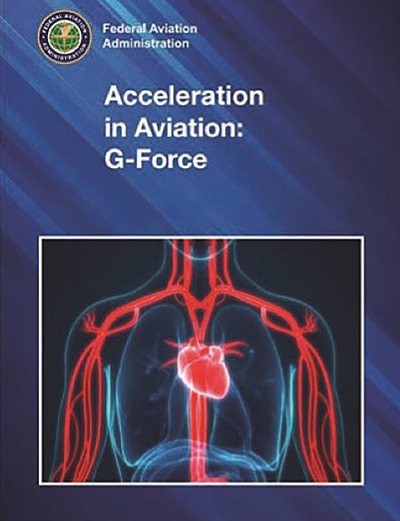PULLING Gs
By Dr. Susan Northrop,
FAA Federal Air Surgeon

As GA pilots, we tend to think of “G-forces” as a concern for aerobatic pilots, but g tolerance should be a concern for all aviators. Recall from ground school that the term g refers to the acceleration from the Earth’s gravity. The term g is also used as a shorthand for an acceleration equivalent to gravity. Hence, one can also experience g’s in turns and changes in speed, such as recovering from a dive.
G-LOCing
Humans are designed to operate in a 1 g environment in our everyday world. This is also true of most situations in the cockpit, but GA airplanes are typically capable of 3.8 g’s in the normal category and 4.4 in the utility category. A level 60 degree bank imposes an acceleration of 2 g’s and 75 degrees 4 g’s. Clearly, this can be a factor for the aircraft. But what about the pilot?
Think of your heart as a pump. When you are sitting or standing, your heart must overcome a fluid column of around a foot in height to perfuse (or supply) your eyes and brain with blood. It is greater for a taller person than one who is shorter, which is why someone who’s shorter has an increased tolerance to g’s. It’s the same for people with higher blood pressure — but at the cost of increased risk of heart disease, kidney disease, and strokes. As you engage in maneuvers that increase g’s, you are, in effect, increasing the height of the fluid column that your heart must overcome. On average, each additional g reduces pressure by 22 mm Hg at eye level.
As g’s increase, pilots typically notice a progressive loss of vision from their peripheral vision towards the center. This may be followed by grey-out, blackout, and eventually lead to a loss of consciousness, called g-induced loss of consciousness or GLOC. Those of you who have had your eye pressure checked know that it ranges between 10 and 20 mm Hg for most (average blood pressure is 120/80 or less). Eye pressure must also be overcome to perfuse the eyes; thus, vision is usually lost before consciousness. But in the event of a rapid g increase, as you might encounter in upset recovery, you could go immediately to GLOC without warning.
If you experience symptoms from g-loading, the only solution is to reduce the g-load and let your body recover. Progression to GLOC can be fatal. Even if the controls are relaxed after GLOC, the following confusion lasts an average of a minute before full recovery…a long time close to the ground.
Why Me?
You may be thinking that the g-limits of a normal category airplane like yours will mean you’re not in any danger. After all, competition and fighter pilots often withstand over 8 g’s. However, remember that these pilots are selected for tolerance, have specific training, engage in fitness programs to increase resistance, and do not fly when ill. Fighter pilots also have g suits.
Factors that can reduce g tolerance include illness, dehydration, fatigue, fasting, and some medications. Additionally, your general fitness and smoking habits can negatively impact your g tolerance. Also, your g tolerance is not a static thing. Much like your health in general, your g tolerance can vary over time. Just because you tolerated a 3 g turn years ago doesn’t mean you could do the same today.
What can you do?
Stay well-hydrated and maintain a well-balanced exercise program with a mix of aerobic and resistance weight training. Activity that is only aerobic in nature may decrease g tolerance.
Like our aircraft, all of us have a limit to our g tolerance. Unlike our aircraft, ours can vary considerably. Exceeding either is not a good path to a happy ending for your flight.
Dr. Susan Northrup received a bachelor’s degree in chemistry, a medical degree from The Ohio State University, and a master’s degree in public health from the University of Texas. She is double board-certified by the American Board of Preventive Medicine in Aerospace Medicine and Occupational Medicine. She is a retired U.S. Air Force colonel and a former regional medical director for Delta Air Lines. She is also an active private pilot.
LEARN MORE
Pilot Minute: Why is Acceleration Tolerance Important for General Aviation? bit.ly/G-ForceLOC
Acceleration in Aviation: G-Force bit.ly/AccGForce
Reprinted with permission from FAA Safety Briefing. Visit the Flight Safety Briefing website: https://www.faa.gov/news/safety_briefing/.



